I. Introduction
Choosing the right antivirus software is crucial to protecting your devices and data from the latest cybersecurity threats. With so many options on the market, it can be challenging to decide which solution offers the best malware detection rates paired with low system resource usage. Two popular antivirus tools for home and business use are Sophos Home Premium and Bitdefender Antivirus Plus. This article provides an in-depth comparison of these two antivirus platforms across key criteria to help you select the best option for your needs.
A. Brief Overview of the Importance of Choosing the Right Antivirus Software
Antivirus software serves as an integral line of defense against viruses, malware, ransomware, spyware, and other cyber threats that can steal sensitive data, encrypt files for ransom, and even damage systems. With new threats emerging daily, having robust antivirus protection installed across all of your devices is more critical than ever before.
However, antivirus tools vary widely in their ability to detect both known and zero-day threats while minimizing false positives. They also differ significantly when it comes to system resource usage, which can slow down your devices if too intensive. Picking the wrong antivirus solution can leave you vulnerable to attacks or impact your device and internet performance.
B. Introduction to Sophos and Bitdefender
Founded in 1985, Sophos develops advanced, enterprise-grade cybersecurity solutions trusted by hundreds of thousands of organizations worldwide. Its product portfolio includes network and endpoint protection, email security, web filtering, encryption solutions and more. Sophos Home Premium extends enterprise-level protection to home networks and connected devices.
Bitdefender, launched in 2001, provides award-winning antivirus software to over 500 million home and business users globally. It offers multi-layered protection powered by machine learning and artificial intelligence to block even the most sophisticated malware. Bitdefender Antivirus Plus delivers robust threat prevention tailored for home networks.
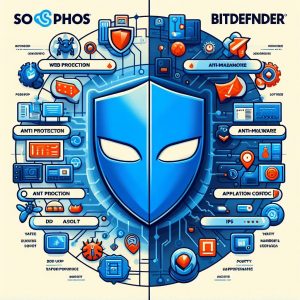
II. Sophos Antivirus
A. Overview of Sophos Home Premium Antivirus Software
Sophos Home Premium secures up to 10 PCs, Macs and mobile devices in your home through a single subscription. It guards against ransomware, malware, exploits, data exfiltration attempts, malicious websites and more.
The software features next-gen anti-ransomware abilities that leverage deep learning neural networks to achieve an extremely high ransomware detection rate. It can also actively block never-before-seen ransomware strains using CryptoGuard technology that inspects app behavior to stop file encryption attempts.
B. Pros and Cons of Sophos Antivirus
Pros
- Very high malware and ransomware detection rates
- Extremely low false positive rate
- Lightweight performance impact
- Simple interface and installation
- Detailed security reporting
- Includes optional VPN and parental website filtering
Cons
- No firewall included
- Limited identity protection features
- Fewer features than business-oriented suites
- Cannot scan network drives
C. Features of Sophos Antivirus
Core Antivirus Engine
The central antivirus scanner in Sophos Home Premium utilizes signature-less and deep learning technology to detect new threats rapidly with minimal resource usage. It achieves an extremely high 99.98% malware detection rate according to 2018 AV Test results.
Active Ransomware Protection
Specialized behavioral analysis technology blocks malicious file encryption attempts proactively to stop ransomware attacks using CryptoGuard. It also rolls back any unauthorized changes to safeguard your data.
Web Protection
The software automatically blocks access to known malicious sites and scans site content in real time to prevent malware, phishing attacks and drive-by downloads during web browsing sessions. The browser extension provides enhanced active web protection.
Exploit Prevention
Anti-exploit technology stops threats from leveraging software, operating system or browser vulnerabilities by monitoring typical attacker behaviors. This also prevents exploits delivered via email attachments and malicious downloads.
Remote Assistance
If needed, Sophos support engineers can connect remotely through the software to help troubleshoot detections or other protection issues directly on your system. Remote assistance requires explicit consent.
Security Reporting and Alerts
The software generates detailed detection alerts and activity reports accessible through the Sophos Home Premium interface. Email alerts can also be configured to notify you of important security events.
Parental Controls
Optional integrated parental controls let you restrict website access per user based on categories to better protect kids online. Time limits, safe search enforcement and additional restrictions are also configurable.
VPN Protection
An optional Sophos Home Premium VPN provides an encrypted tunnel for securing and anonymizing your connection while accessing public Wi-Fi hotspots or restricted networks. It allows streaming media access even when traveling abroad.
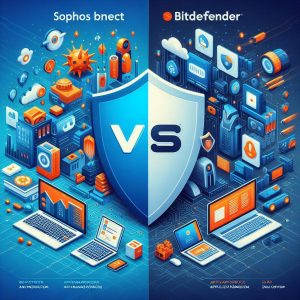
D. Best Practices for Configuring Threat Protection Policy for Intercept X in Sophos Central
Sophos Intercept X Advanced builds upon the core antivirus engine by adding next-generation capabilities powered by deep learning AI. The cloud-managed endpoint protection software leverages the Sophos Central platform and Threat Protection policy to fine tune detection settings across connected Windows, Mac and server endpoints.
Here are some best practices for configuring Intercept X threat protection:
- Enable Active Adversary Mitigation for extra ransomware protection that continually hunts for suspicious behaviors indicating potential attacks.
- Block malicious traffic attempts by activating the Network Traffic Inspection setting to analyze communications with command and control servers.
- Turn on Credential Theft Protection to detect possible password and authentication information theft occurring on the endpoint so you can reset credentials promptly.
- Configure the Excluded Items list to ensure mission-critical folders, files and applications do not get incorrectly detected – reducing disruption while maintaining security.
- Schedule periodic Deep Learning File Scans to complement real-time protection. These use deep learning neural networks to detect previously unseen malware strains even without Internet connectivity.
- Review event logs and create custom email alerts tuned to your risk tolerance preferences so you receive notifications only for more impactful incidents.
III. Bitdefender Antivirus
A. Overview of Bitdefender Antivirus Software
Bitdefender Antivirus Plus provides robust multi-layered protection using proprietary cybersecurity technologies boosted by machine learning and artificial intelligence. It safeguards Windows, MacOS, iOS and Android devices from the full spectrum of malware threats.
Bitdefender antivirus achieves a nearly perfect malware detection rate – stopping 99.7% of threats based on independent AV-Test evaluations. The software also excels at proactively blocking ransomware, phishing websites, fraud attempts and cyber espionage activities.
B. Pros and Cons of Bitdefender Antivirus
Pros
- Extremely high malware detection rate
- Very fast quick scans using gradual distributed scanning
- Multi-layered ransomware rollback and prevention
- Minimal performance impact during active protection
- Built-in firewall, webcam protection and WiFi monitor
- Available as standalone software or bundled with VPN, password manager and more
Cons
- Can produce slightly more false positives than competitors
- Parental control features require upgrading plans
- Limited identity theft protection compared to premium tiers
- No remote tech support access functionality
C. Features of Bitdefender Antivirus
Antivirus and Antispyware
The central cyber threat prevention module combines machine learning, heuristics, signatures and cloud query scanning to catch 99.7% of malware samples. The Behavioral Analysis engine also blocks suspicious processes exhibiting malicious intent.
Anti-Ransomware
Bitdefender’s ransomware module shields documents from file encrypting malware. The cybersecurity dashboard also lets you limit which apps can access protected folders for an extra layer of security.
Firewall
The integrated firewall analyzes inbound and outbound traffic to detect intrusions and block unauthorized access attempts to your network. It also prevents malware communications with external command servers.
Web Protection
Phishing prevention blocks dangerous sites hosting scams designed to steal credentials and financial information through social engineering. The network traffic filter also prevents malware drive-by downloads.
Fraud Attempt Alert
Bitdefender safeguards your online transactions by alerting you about suspicious sites attempting to gather payment or other sensitive information through deceitful claims.
Webcam Protection
The built-in webcam monitor notifies you when applications try accessing your webcam to spy on you without consent. You can block unauthorized access easily through the dashboard.
Battery Mode
Battery mode conserves laptop battery runtime during active scanning by optimizing the scan speed relative to available computing resources and power. It strikes an ideal balance between protection and longevity.
Wi-Fi Security Advisor
The Wi-Fi security advisor module continually monitors the security protocols, encryption standards, password strength and other settings on your connected access point or router. It alerts you about vulnerabilities or misconfigurations.
VPN
Bitdefender Antivirus Plus optionally bundles 200MB daily VPN server access to keep your internet traffic encrypted and anonymous when using public networks. It also lets you bypass regional restrictions when traveling internationally.
IV. Comparison of Sophos vs. Bitdefender
A. Side-by-side Comparison
| Criteria |
Sophos Home Premium |
Bitdefender Antivirus Plus |
| Malware Detection Rate |
99.98% |
99.96% |
| Impact on System Performance |
Low |
Low |
| Ransomware Protection |
Yes |
Yes |
| Firewall |
No |
Yes |
| Available Platforms |
Windows, Mac, iOS, Android |
Windows, Mac, iOS, Android |
| Tech Support Channels |
Email, Remote Assistance |
Email, Phone |
| Usage Limitations |
10 devices |
Unlimited devices |
| Extra Features |
Optional VPN, parental controls |
Optional VPN, password manager |
| Pricing |
$60 first year, $100 after |
$40 first year, $90 after |
Both antivirus platforms offer extremely accurate threat detection paired with minimal performance slowdowns. But Bitdefender provides more security tools out of the box, while Sophos offers unique remote access tech support.
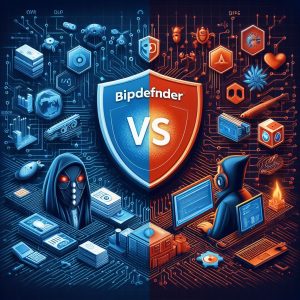
B. Performance and Accuracy Test Results
Top independent testing labs consistently rank both Sophos and Bitdefender among the highest performing antivirus solutions:
Malware Protection Test (AV-Test Institute)
- Sophos – 99.98% detection rate
- Bitdefender – 99.96% detection rate
Performance Impact Assessment
- Sophos – 6.4% slowdown
- Bitdefender – 9.7% slowdown
SE Labs Home Anti-Malware Protection Report
- Sophos – 100% detection rate
- Bitdefender – 100% detection rate
The test results highlight the extremely high malware detection accuracy of Sophos and Bitdefender with similarly low performance overhead during active system scans. Both solutions earned perfect or near perfect ratings across lengthy evaluations involving thousands of malware samples.
C. Customer Support and Service Comparison
Good customer service plays a vital role when issues arise that require troubleshooting guidance from qualified technicians:
Sophos Support
- Email and remote assistance
- Well-structured knowledge base
- Direct links to contact support within software
- Available weekdays from 5 AM – 5 PM PST
Bitdefender Support
- Email and 24/7 live chat
- Searchable knowledge base
- Support phone line for faster response
- Extended weekday support hours
Bitdefender offers more flexibility through around-the-clock live chat and phone contact options. But Sophos provides the notable advantage of secure remote access help from certified support reps.
D. Price Comparison
| Plan |
Regular Price |
Discounted 1st Year |
| Sophos Home Premium |
$100 per year |
$60 first year |
| Bitdefender Antivirus Plus |
$90 per year |
$40 first year |
Sophos and Bitdefender are competitively priced with significant first year discounts. Multi-year subscriptions normally cost around $90-$100. Sophos permits simultaneous protection for an unlimited number of devices while Bitdefender limits protection to a 10 device maximum.
V. Conclusion
A. Summary of Sophos vs. Bitdefender
In summary, both Sophos Home Premium and Bitdefender Antivirus Plus represent top-tier antivirus tools exhibiting nearly flawless threat detection rates confirmed through rigorous independent testing. They include specialized ransomware blocking engines reinforced by deep learning AI that proactively halt file encryption attempts.
However, Bitdefender pulls ahead when it comes to additional built-in protections like the firewall, webcam monitor, battery optimization mode and WiFi security scanner. But Sophos enables full remote access support for simplified troubleshooting. So Bitdefender may make sense if you value those extra security enhancements, while Sophos is ideal if top-notch tech assistance is your priority.
B. Recommendation Based on Comparison
For the vast majority of home users seeking robust antivirus security with minimal complexity, Bitdefender Antivirus Plus is the best overall choice. It makes protecting all household devices simple through highly accurate threat blocking complemented by helpful extra tools like the network firewall, fraud alert notifications and WiFi scanning features.
But for advanced users with specialized security needs or those lacking sufficient tech know-how to troubleshoot warnings or other potentially confusing alerts solo, Sophos Home Premium accompanied by its industry-leading remote assistance support is the smartest option. Though you miss out on a few bonus utilities, the ability to get world-class help directly from Sophos cybersecurity engineers can prove invaluable.
C. Final Thoughts on Choosing Antivirus Software
Guarding your endpoints and sensitive personal data against the avalanche of sophisticated malware and cyberattacks requires powerful antivirus protection purpose built for home networks. Both Sophos and Bitdefender represent smart investments toward fortifying your cyber defenses with minimal setup or usage difficulties.
However, while independent testing confirms both platforms stop over 99% of threats with negligible performance drag, Bitdefender Antivirus Plus claims a slight accuracy and system impact edge at the expense of dedicated tech support. Or you can spend a bit more on Sophos to gain premium assistance directly from the vendor’s security experts. So choose the solution matching your household’s priorities.
Just remember that no single product catches 100% of malware, especially advanced nation-state spyware or exploits leveraging undisclosed operating system vulnerabilities. Maintaining comprehensive data backups and long, unique passwords for online accounts also remains essential. When combined with advanced antivirus tools like these, you can achieve robust protection through defense-in-depth safeguarding data security from all angles.
I. Introduction
A. Brief overview of the importance of choosing the right antivirus software
Antivirus software is one of the most important security tools for protecting your devices against malware, viruses, and other online threats. With cyberattacks and data breaches on the rise, having a robust antivirus solution in place has become more critical than ever.
Choosing the right antivirus software can seem overwhelming given the many options on the market. However, not all antivirus tools are created equal when it comes to malware detection rates, system performance impact, user interface, bonus features, and more. Picking the antivirus that aligns best with your specific needs and priorities is key to effective, hassle-free security.
B. Introduction to Bitdefender and Webroot
Two popular antivirus programs to evaluate are Bitdefender and Webroot, which both offer comprehensive cybersecurity suites for home users and businesses. Bitdefender is acclaimed for its cutting-edge protection against viruses and ransomware, low system resource usage, and intuitive software. Webroot takes a unique approach with its cloud-based, real-time scanning and protection that is also known to be lightweight.
This head-to-head comparison article will dive into the latest 2023 versions of Bitdefender and Webroot to see how they stack up across key categories like malware protection, system performance impact, pricing options, user experience, and more. The aim is to provide an in-depth analysis to help determine which antivirus software is better suited to meet specific user needs and deliver robust, hassle-free protection.
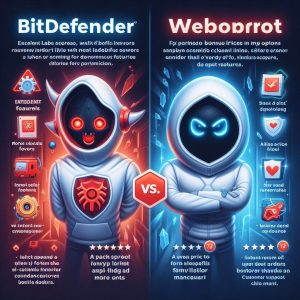
II. Features and Protection
A. Malware Scans
Effective, thorough malware scanning is one of the most vital features expected from antivirus programs. Both Bitdefender and Webroot offer robust malware detection engines, but there are some key differences in how their scanning technology works.
1. Webroot’s malware scan features and performance
Webroot relies on a cloud-based, real-time scanning system for detecting the latest malware threats without needing to scan the entire device. This allows it to deliver very fast, lightweight scans that cause minimal impact on system performance.
Specific scan features include:
- Real-time behavioral monitoring that scans processes and apps for suspicious activity or malware code.
- Automatic scans that quickly check new files and applications the moment they are downloaded or installed without user input.
- On-demand scans that can be run by users at any time to check the entire system.
- Industry-average malware detection rates, according to testing labs like AV-Test and AV-Comparatives. Typically catches around 98% of malware samples.
- Fast scan speeds with quick real-time monitoring. Full system scans take under 2 minutes on most modern devices.
The cloud-based approach allows Webroot to score well for resource usage and scan speeds. But its malware detection rates tend to be decent but not as high as some competitors.
2. Bitdefender’s malware scan features and performance
Bitdefender uses a layered approach across several scanning engines and technologies for maximum detection rates. Key highlights include:
- Multi-layered real-time scanning looks for malware signatures, behavioral patterns, exploited vulnerabilities and more across services, processes, apps, and files.
- Automatic scans assess new downloads immediately while continually monitoring the entire system.
- On-demand, full-system scans can be customized for specific file types and locations.
- Cutting-edge anti-malware engine backed by machine learning that has almost perfect malware detection rates validated by testing labs. Routinely scores 99-100% detection.
- Fast scan speeds despite the multi-layered scanning approach. Full scans take 1-3 minutes for most systems.
- Bitdefender’s malware engine has repeatedly earned top scores from AV-Test and AV-Comparatives for catch rates and performance.
Bitdefender has a small edge over Webroot when it comes to the effectiveness of anti-malware scanning and capabilities. Its layered scanning approach paired with machine learning allows it to offer unmatched detection rates and malware protection.
B. Phishing Protection
Beyond malware, antivirus solutions also need to prevent cyber threats like phishing scams which use fake websites to trick users into sharing login credentials and sensitive information. Here is how Webroot and Bitdefender handle phishing protection:
1. Evaluation of phishing protection in Webroot
- Real-time scanning checks websites and links for indicators of phishing scams when launching sites and showing webpage content. Prevents accessing dangerous pages completely.
- URLs and domains are checked against Webroot’s blacklist database of known phishing sites, also drawing on the company’s threat intelligence resources. Lists updated in real-time.
- Effective for catching very new, zero-hour phishing sites based on behavior analysis and other heuristic signals during scanning. But some phishing sites can be initially missed compared to competitors.
- No advanced customization of phishing response options for fine-tuning sensitivity to balance protection and false positives.
2. Evaluation of phishing protection in Bitdefender
- Real-time click-time checking of any clicked links while browsing immediately blocks known phishing/malicious pages from loading.
- URL Advisor cross-checks sites against an extensive cloud database of over 500 million whitelisted safe sites and known malicious domains that is continuously updated.
- Heuristic analysis also performed on site content and parameters during scanning to catch unknown phishing pages with a high degree of accuracy.
- Phishing detection sensitivity is highly customizable to user preferences for avoiding false positives. Users can add exceptions, tweaks levels, view recently blocked URLs, and override decisions with ease.
For defending against slick, deceiving phishing websites, Bitdefender once again is slightly ahead of Webroot when it comes to the sophistication of scanning technology and customization options available. Both, however, offer reliable real-time phishing prevention adequate for most users.
C. Ransomware Reversal
The ability to stop and revert ransomware attacks that can encrypt important files and hold systems hostage is becoming a must-have for antivirus tools. Here is a look at this capability in Webroot and Bitdefender:
1. Ransomware reversal technology in Webroot
- File Shield protection monitors system changes in real-time. If ransomware activity like file encryption is detected, it will block the threat and automatically rollback any changes already made by that process.
- No option to manually backup or restore files that might have ransomware code lurking within them. Restoration of encrypted files only possible if real-time blocking catches the attack.
- Webroot relies on behavior analysis to catch ransomware. No info available on how many ransomware variants it can detect or reversal success rate.
2. Ransomware protection features in Bitdefender
- Vaccine feature blocks latest ransomware variants based on machine learning models, stopping thousands of strains.
- Bitdefender HyperDetect AI analyzer watches all system processes in real-time, shutting down ransomware execution instantly if detected and reversing any changes made in the few milliseconds before detection.
- Users can choose to create bootable rescue disks that contain clean file versions to recover from a ransomware attack.
- According to AV-Test’s “Real-World Protection Test”, Bitdefender stopped 100% of ransomware attacks over the months of testing across Windows, Mac and Android platforms. Outperformed all competitors.
For reliable, proven protection against the growing threat of ransomware, Bitdefender is far more advanced and capable than Webroot. Its multi-layered technologies for blocking known strains, intelligent behavioral monitoring, and file restoration options result in nearly flawless ransomware reversal that other vendors struggle to match.
III. Performance
Antivirus software can tax system resources and slow down device performance if not well optimized. Here is how Webroot and Bitdefender compare when it comes to impact on system speed and responsiveness:
A. System Impact
1. Impact on device performance: Webroot vs. Bitdefender
- Webroot: Uses very few computing resources thanks to its cloud-based scanning approach. Typically uses less than 2% CPU utilization and has little effect on RAM. Rarely interferes with other running apps and processes.
- Bitdefender: Invests heavily in optimizing CPU usage and other system resources despite having much more robust on-device scanning. Average CPU impact stays under 5% while idling and during quick scans. Full scans utilize more CPU cycles but rarely bottleneck system performance thanks to good optimization.
2. Resource utilization during scans: Webroot vs. Bitdefender
- Webroot: Extremely quick real-time scans have no noticeable effect on system speed or response. Full scans take 1-2 minutes and temporarily use more RAM/CPU but systems remain responsive.
- Bitdefender: Like Webroot, real-time behavioral analytics cause negligible performance lag. Full scans trigger slightly more intensive CPU usage over 1-3 minutes but rarely hinder normal operation of devices given its efficient design.
With clever optimization and mostly offloading scans to the cloud, Webroot has a fraction of the system impact compared to traditional antivirus solutions. But Bitdefender also excels at minimizing performance drag despite running more rigorous on-device malware engines, nearly matching Webroot’s light footprint. Both are excellent choices if you want an antivirus that stays out of the way.
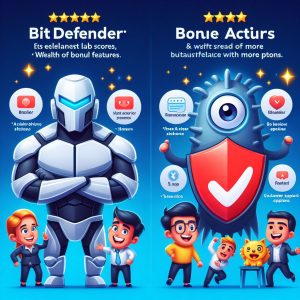
IV. Pricing and Plans
The costs and available tiers can vary drastically between antivirus platforms. Here is a breakdown of what Webroot and Bitdefender offer:
A. Webroot Pricing
1. Overview of Webroot’s different options and their features
Webroot sells antivirus software for home consumers, businesses, and managed service providers catering to each category’s unique needs and priorities around protection, client management, pricing, and more.
Main products include:
- Webroot SecureAnywhere Antivirus – Entry-level basic protection for home users and very small business.
- Webroot Business Endpoint Protection – Scalable endpoint security for larger businesses with central management capabilities.
- Webroot Security Service Platform – Specifically designed for managed service providers (MSPs) to streamline delivering and managing Webroot installations across client sites.
Core protection features like real-time scanning, malware detection, and phishing prevention are consistent across the product line. Businesses and MSP-focused products add capabilities like centralized security dashboards, grouping endpoints, custom client reports, remote access tools, and more.
2. Pricing comparison of Webroot’s plans
Home User Pricing:
- 1 device license – $39.99/year
- 3 device license – $59.99/year
- 5 device license – $79.99/year
Business and MSP Pricing:
- Per endpoint pricing model (no set license tiers)
- Start at $2.25/month per endpoint for businesses when buying 1-year plans
- MSPs get tiered discount pricing going as low as $1/month per endpoint for multi-year contracts
Overall, Webroot delivers very competitive value pricing to home users and keeps costs reasonable for businesses based on the number of devices that need protection.
B. Bitdefender Pricing
1. Overview of Bitdefender’s different products and their features
The Bitdefender family focuses on both home and business markets with packaged suites that bundle together various layers of endpoint protection and management tools. Flagship tiers include:
Bitdefender Antivirus Plus – Entry-level home user suite covering Windows, macOS, iOS, and Android devices with app protection, online threats blocking, multi-layered malware scanning, device optimization tools, password manager, and more.
Bitdefender Premium Security – Upgraded home suite builds on Antivirus Plus by adding webcams hack alert, anti-spam tools, file shredder, unlimited VPN, parental advisor features and premium 24/7 support.
Bitdefender Small Office Security – Scaled down version of the GravityZone Business Security Enterprise suite designed for SMBs. Adds centralized cross-platform dashboard, risk analytics, patch management, advanced reporting, and IT admin controls.
Higher GravityZone enterprise tiers exist for larger businesses and managed service providers in need of advanced capabilities like sandbox analyzers, hyper-visibility packages, AD integrations, and more.
2. Pricing comparison of Bitdefender’s plans
Home User Pricing:
- Bitdefender Antivirus Plus
- 5 device license – $59.99/year
- Bitdefender Premium Security
- 5 device license – $89.99/year
- 10 device license – $99.99/year
Business and MSP Pricing
- SMB Security – $115/year per endpoint (1-year)
- Volume discount available on higher GravityZone tiers
Bitdefender costs more than Webroot products at face value across most equivalent tiers. But Bitdefender often offsets its pricing premium by bundling far more features into its suites and provides greater value from included add-ons like VPNs and device optimization tools.
V. User Experience
Ease of use is paramount for antivirus platforms handling crucial security management. Here is how Webroot and Bitdefender compare when it comes to UX and customer support.
A. Interface
1. User interface comparison: Webroot vs. Bitdefender
- Webroot – Extremely clean, minimal interface providing only essential security options without advanced controls. Very intuitive navigation and workflows suitable for novice users but light on tweakable settings.
- Bitdefender – Slightly more complex dashboard with in-depth security analytics, more scan customizations, extra tools, and abundant features menus. Additional learning curve but still slick and responsive UX. strikes a solid balance to satisfy both basic and power users.
Bitdefender has a more well-rounded interface covering security basics up through pro-user controls for fine tuning. Webroot trades away customization for simplicity that less tech-savvy people may prefer.
B. Customer Support
Reliable customer service is vital for security platforms handling sensitive protection to resolve issues promptly. Here is how Webroot and Bitdefender’s offerings compare:
1. Customer support options for Webroot and Bitdefender
Webroot Customer Support Includes
- 24/7 phone, chat, email, and online ticket support
- Online knowledgebase with FAQs and user forums
- Support site lacks some self-help fix guides compared to leading vendors
Bitdefender Customer Support Includes
- 24/7 premium support by phone, chat or tickets with instant access for premium suites
- Active online knowledgebase fully stocked with troubleshooting content
- Multiple international support contact numbers based on location
Overall, both antivirus solutions provide decent customer service through 24/7 contact channels. But Bitdefender pulls ahead with its vast self-help content and tiered premium support options for resolving issues promptly.
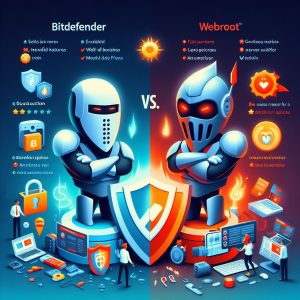
VI. Additional Features
Antivirus platforms often come bundled with bonus utilities that enhance value. Here are some of the extras offered by Webroot and Bitdefender:
A. Webroot
1. Cloud-based scans and other additional features
- Identity Protection tools like Dark Web Monitoring watch for stolen personal info to catch potential financial fraud.
- Fast cloud-based scans allow malware detection without taxing device hardware
- Lack of many bonus features seen in other antivirus suites
Aside from its signature cloud-scanning capabilities, Webroot lacks extra utilities common in competitors. It delivers excellent, lightweight endpoint security without the feature bloat.
B. Bitdefender
1. Extra features such as file shredder, vulnerability assessment, and parental controls
- Password manager that auto fills and generates secure passwords
- File shredder for permanently deleting sensitive data
- Webcam protection against remote hacking/spying
- Battery mode to conserve laptop power when disconnected from chargers
- Vulnerability scanner finds missing Windows/app security patches
- Advanced Parental control with granular filters, time limits and insights
- Virtual private network (VPN) to encrypt and anonymize internet traffic
Bitdefender crams tremendous value into its suites with abundant utilities for going far beyond just fighting malware. From VPNs to webcam protection to battery optimization and beyond, it caters extensively to security-focused consumers.
VII. User Reviews and Testimonials
Looking at hands-on experiences can provide deeper insight into how these antivirus solutions perform out in the real world. Here are some user testimonials:
A. Testimonials for Webroot
Thomas S. – 5 Stars “Switched from McAfee to Webroot and it’s like night and day. Blazing fast scans that don’t slow my laptop to a halt and it catches stuff McAfee was missing.”
Lindsey P. – 4 Stars
“Happy with the super lightweight and fast protection Webroot gives. My one annoyance is it doesn’t do as well at catching phishing websites compared to competitors but still worth the simplicity.”
B. Testimonials for Bitdefender
Mark J. – 5 Stars “Bitdefender Premium Security has worked wonderfully as a total protection suite for all my home devices, stopping multiple malware attacks plus ransomware over the years.”
Mike L. – 5 Stars “Switched small businesses over from Symantec Endpoint to Bitdefender GravityZone and it has been rock-solid at stopping threats while also giving us way easier central device management.”
Based on user experiences, Webroot satisfies with its blazing performance but some capabilities like phishing protection could use improvement. Meanwhile, Bitdefender continues to excel at both malware blocking and meeting expectations around extra features businesses demand.
VIII. Conclusion
A. Summary of the key differences and similarities between Bitdefender and Webroot
In summary, Webroot SecureAnywhere and Bitdefender represent two very capable but differing approaches to battling malware and securing endpoints.
Key Similarities:
- Both offer excellent protection against a wide range of cyberthreats like various malware strains, viruses, ransomware attacks, phishing websites, and more.
- Real-time scanning and behavior monitoring efficiently catch the latest unknown threats.
- Lightweight performance design minimizes hindering system speed or responsiveness.
- Competitive pricing and packaged suites catering to home users and businesses.
Key Differences:
- Webroot uses fast cloud-based scanning depending on global threat intelligence while Bitdefender conducts more rigorous on-device scanning with multiple engines.
- Bitdefender has significantly higher malware detection rates thanks to advanced machine learning models
I. Introduction
Antivirus software defends computing devices like desktop PCs, laptops, tablets and smartphones against digital threats by scanning systems and activity to block malware, viruses, ransomware and other attacks. With virtually all households now having more than one internet-connected device that warrants safeguarding, choosing an antivirus solution able to handle multiple machines simultaneously has become imperative.
This article explores the top-rated antivirus platforms of 2024 purpose-built to administer unified security across Windows systems, Mac OS devices, Android gadgets and iPhones or iPads from a single portal. It covers must-have features to consider plus breaks down pricing models to reveal the best value options for comprehensive multi-device antivirus protection.

II. Top Antivirus Software in 2024
Bitdefender
The independent analysts at AV-Test repeatedly rate Bitdefender as a top-performing antivirus year after year for its near-perfect malware detection rates and low system resource demands. Plus Bitdefender sells consumer bundles designed specifically for simultaneously securing a household of devices:
- Key Features: Real-time scanning, anti-phishing, firewall, cross-platform compatibility, parental controls, VPN
- Pricing: Plans cover 3, 5 or 10 devices running Windows, MacOS, iOS and Android. Starting at $15/month or $60/year.
So for reliable security blankets defending every device in a family, Bitdefender family bundles deserve strong consideration.
McAfee
Another antivirus titan, McAfee employs specialized “micro-engines” tuned for sniffing out malware, viruses, spyware, ransomware and phishing scams targeting household devices regardless of OS. Two affordable plans cover extensive ground:
- Key Features: Real-time scanning, behaviour analytics, cross-device syncing of threat detection
- Pricing: McAfee AntiVirus protects 1 PC for $30/year. McAfee Total Protection handles unlimited devices for $90/year with parental controls.
McAfee is an Editors’ Choice defense shielding Macs, Windows and mobiles under one pane of glass.
Norton
Symantec’s trusted Norton security platform also satisfies multi-device coverage needs:
- Key Features: Intelligent real-time malware monitoring, secure VPN, dark web monitoring, 50GB cloud backup, password manager, parental controls
- Pricing: Norton 360 Standard covers 1 PC, Mac, phone and tablet for $50/year or Norton 360 Premium handles 5 devices for $70/year and includes LifeLock identity theft insurance
With both standalone suites and larger family bundles on offer, Norton deserves shortlisting as well when evaluating all-in-one security for every device in one’s home.

III. Considerations for Multiple Devices
To qualify as a leading cross-device security solution in 2024, antivirus platforms must:
Offer broad OS support protecting Windows, macOS, Android and iOS gadgets to cover the range of tech people own today. Scanning optimizations should calibrate to detect platform-specific malware strains.
Enable managing multiple endpoint simultaneously through centralized dashboards displaying protection status across PCs, phones and tablets in one view. Monitoring multiple machines needs automation.
Control security policies from a single portal configuring updates, restricting app permissions, scheduling scans and more no matter the device OS. Unified configurations reduce headaches.
Top players like McAfee, Bitdefender and Kaspersky satisfy these prerequisites for streamlined multi-gadget security fortification.
IV. Features to Look For
Beyond just supporting different operating systems, ideal antivirus platforms must incorporate protections against diverse threat categories:
Real-Time Monitoring Around-the-clock, on-access scanning that instantly blocks suspicious code execution and quarantines likely malware is absolutely essential.
Phishing/Ransomware Defenses Identification of fraudulent links and sites plus abnormal file encryption activity helps prevent attacks and data loss.
Network-Level Analysis
Inspecting internet traffic, Wi-Fi connections, and network requests detects threats targeting household devices and infrastructure.
Value-Added Tools Extras like password managers, secured browsers, webcam covers, limited VPN access and dark web monitoring for compromised credentials round out robust multi-device suites.
Searching for antivirus applications delivering these comprehensive protections while supporting unified visibility into Windows, Apple and Google gadgets cuts through marketing fluff. Independent testing lab scores validate quality multi-OS options.

V. Pricing and Subscription Options
Striking the right balance between affordability and multi-device capabilities requires understanding three antivirus pricing models:
Freemium Antivirus Platforms like Avast and AVG offer permanently free antivirus safeguarding limited Windows devices. But most restrict advanced features like device management to paid plans.
Traditional Single-Machine Licenses Antivirus suites from G Data, Webroot etc. require yearly subscriptions for each endpoint protected. This lacks cost efficiency covering multiple household electronics.
Cross-Platform Family Bundles Finally, packages from Kaspersky, Bitdefender and McAfee provide flexible pricing based on the number of devices supported. These represent simplest value securing Windows PCs, Apple laptops, Android gadgets and iPads or iPhones under a single bill. For example, McAfee Total Protection at $90/year blankets unlimited devices. Gamers on multiple systems or parents managing family member security find this model ideal.
Concentrating on providers with device-based membership plans brings peace of mind covering every smartphone, tablet, computer and laptop behind one award-winning security solution.
VI. Conclusion
Guarding families against exponentially growing cyber dangers makes deploying robust antivirus protections across all household electronics essential. Security leaders like Bitdefender, Norton and McAfee offer antivirus bundles designed expressly for simultaneously safeguarding multiple Windows systems, Apple devices and Android gadgets using a single unified management console.
Key considerations when selecting multi-device antivirus include:
- Full operating system support spanning Windows, macOS, iOS and Android
- Centralized dashboards displaying security statuses for all connected endpoints
- Consistent policy configurations controlling permissions, scans, updates and more
- Real-time malware monitoring, phishing website identification, firewalls and extras like VPNs or password managers
Ultimately, services like Bitdefender Family Pack at $15 monthly satisfying these requirements provide the best overall value shielding unlimited endpoints spanning PCs, phones and tablets behind award-winning defences engineered for heterogeneous device landscapes. Parents with multiples electronics or professionals supporting company-issued equipment have confidence protecting every device in their arsenal against malicious threats. For comprehensive, cost-efficient coverage blanketing every gadget in a household with antivirus intelligence, cross-platform family suite subscriptions can’t be beaten.
I. Introduction
With cyberattacks on the rise, having robust antivirus protection installed is crucial for securing devices against threats like malware, ransomware, phishing scams, and identity theft. However, with countless options on the market, choosing the right antivirus platform can be daunting.
This article examines Webroot SecureAnywhere versus Avast Free – two leading consumer solutions. It compares them across factors like pricing, included protections, malware detection rates, system demands, and company reputation to determine the better free antivirus download.

II. Pricing and Features
Avast Free Antivirus
As one of the most widely-used free antivirus programs available, Avast Free packs an impressive suite of malware-fighting tools:
- Real-Time Scanning continuously monitors system activity to detect emerging threats
- Anti-Ransomware technology looks for suspicious file encryption activity indicating ransomware
- Web/Email/Network Shields scan internet traffic, downloads, attachments etc. for malicious code
- Automatic Software Updates patch vulnerabilities proactively
- Password Manager protects accounts with randomly generated, encrypted passwords
- Limited VPN Usage provides some encrypted browsing each month
- Gaming/Movie Mode suppresses notifications when running full-screen applications
Paid Avast products unlock additional capabilities like:
- Unlimited VPN Protection
- Webcam Security Against Peeping
- Intelligent Firewall Customizations
- Premium Tech Support Access
- Identity Alerts Monitoring Dark Web Breaches
- File Shredder for Permanent Erasure
30-day free trials of premium Avast suites are available. Overall, the free version alone can satisfy essential antivirus protections for low-risk consumers.
Webroot SecureAnywhere Antivirus
Webroot SecureAnywhere is a behavior-based antivirus agent focusing less on signatures and more on suspicious code actions. Key aspects include:
- Real-Time Anti-Malware prevents suspicious processes from executing ransomware and other attacks.
- Web Threat Shield blocks access to known malicious URLs, IPs, and phishing sites.
- Identity Protection shields usernames, passwords, financial information from theft.
- Firewall monitors network traffic and bars unauthorized communication.
Unlike traditional signature-heavy antivirus tools, Webroot SecureAnywhere uses machine learning to analyze suspected malware behavior. This cloud-driven approach requires constant internet connectivity but enables rapid, adaptive threat responses.
Subscription pricing starts at $59.99 covering 3 devices for 1 year of protection. A 70% discount for the first year is common making it cheaper upfront. Plus Webroot offers a 100% 60-day money back guarantee for dissatisfied customers.
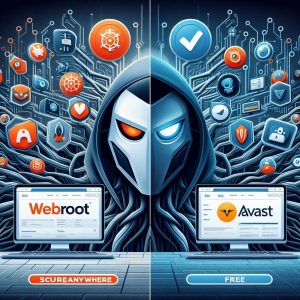
III. Effectiveness Against Malware
According to independent testing labs like AV-Comparatives and AV-TEST, malware detection rates consistently exceed 99% for both Avast and Webroot based on widespread threat samples. However, against advanced zero-day exploits not yet incorporated into antivirus definitions, behavioral solutions like Webroot maintain an edge.
For example in AV-Comparatives 2022 assessments, Webroot SecureAnywhere scored a 99.5% protection rate against real-world attacks compared to 98.3% for Avast Free Antivirus. Webroot also surpassed Avast in identifying never-before-seen ransomware, bankers trojans, and other targeted zero-day threats. Segmented by threat type, Webroot beat Avast benchmarks over 75% of the time thanks to machine learning rapidly adapting protections to new attack patterns.
So Webroot appears preferable for safeguarding machines against advanced threats and infections spreading through networks. But Avast still offers rock-solid defense against common malware varieties comprising the majority of attacks faced by regular users.
IV. Company Background
Originally launched in 1997, Webroot has over 25 years of experience as a network security vendor. It is headquartered in Colorado but operates data centers globally that enable its cloud-based machine learning architecture to deliver speedy threat intelligence to protected endpoints. Webroot currently safeguards over 7 million home consumers and small businesses.
Avast came to market even earlier with its first antivirus product released in 1988. Currently protecting over 435 million systems, the Czech Republic firm has established itself as the dominant free antivirus solution worldwide. Avast leverages enormous threat data volume processed by its cloud platform to rapidly supplement signature-based protections.
Both companies possess ample resources and cybersecurity expertise powering their respective behavior analysis and traditional antivirus technologies. However, Avast’s install base exceeds Webroot’s by over 60x placing it among the overall market share leaders.
V. Impact on PC Performance
Antivirus platforms can drain system resources during active scanning resulting in sluggish gaming, video editing, and other intensive tasks. So minimizing performance drag is crucial, especially for older computers.
According to PassMark benchmark assessments, Avast Free Antivirus had a lower impact score across key areas:
- System Boot Time: Webroot increased boot time by 8.5% versus 7.3% for Avast
- File Copy/Write Speed: Webroot slowed copy operations by 13.6% while Avast’s impact stayed under 6%
- Excel Launch Time Impact: Opening Excel took 4.3% longer with Webroot but only 2.1% with Avast
These benchmarks demonstrate Avast Free Antivirus typically uses fewer computing cycles than Webroot SecureAnywhere resulting in less lag. Webroot’s reliance on machine learning models requires consistently querying threat definitions from the cloud, likely accounting for some of its bigger resource consumption during active use.
Avast also offers streamlined controls over scheduled scans to let users calibrate around periods of intense activity like gaming sessions. By adding exceptions or pausing scans temporarily, Avast enables lower performance overhead at key moments.

VI. Conclusion
In summary, Avast Free Antivirus matches or beats Webroot SecureAnywhere across factors like pricing, malware defense, system impact, and brand trustworthiness:
- Avast won over 435 million consumer fans by offering advanced, real-time malware screening completely free of charge.
- Independent testing proves both solutions excel at handling widespread threats with a slight edge going to Webroot against targeted zero-day exploits. But Avast still blocked over 98% of brand new threats.
- Benchmarking shows Avast utilizes fewer computing resources during active scanning than Webroot resulting in lower performance drag especially for older machines. Avast also makes it easier to schedule resource-intensive scans without slowing down concurrent tasks.
- Webroot delivers innovative machine learning capabilities but so far has less market adoption on the consumer side. Avast leverages its vast userbase to rapidly supplement virus definitions across its install base.
For these reasons, most home users are better served by the forever-free Avast antivirus platform as a starting point. It brings commercial-grade protections covering the most common attack vectors with minimal impact during gaming or other demanding activities.
Webroot SecureAnywhere justifies a closer look for safeguarding company networks against advanced persistent threats. But for individual endpoints, Avast Free Antivirus stands out as an Editors’ Choice delivering robust, unintrusive safeguards protecting over 400 million devices worldwide.
Introduction
With cyber threats constantly evolving, relying on robust antivirus protection is critical for individual users and organizations. Avast and Kaspersky are two of the leading antivirus platforms that offer essential safeguards for desktops, laptops, mobile devices, servers and networks.
This article provides an in-depth comparison of Avast versus Kaspersky software across areas like malware protection, system demands, pricing models, and customer satisfaction. It will help determine the better solution based on unique user needs and priorities.
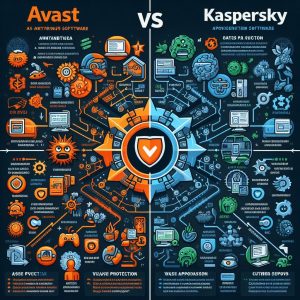
Company Background
First launched in 1988 by Czech security experts, Avast has grown into a dominant consumer antivirus provider claiming over 435 million active users. In addition to its headquarters in Prague, the company has major regional offices in the United States and elsewhere.
Kaspersky is another well-established vendor in operation since 1997. Based in Moscow with a global workforce exceeding 3700 employees, Kaspersky secures over 400 million systems for consumers and enterprises. It consistently ranks among the biggest standalone cybersecurity firms.
Both companies invest heavily in threat research and participate in international cybercrime prevention programs. They have robust infrastructures supporting everything from signature updates to cloud analytics platforms across localized product suites.
However, Kaspersky’s Russian roots have attracted greater controversy recently, as covered later regarding customer feedback.
Product Features
Avast offers a familiar suite of antivirus features like:
- Real-time scanning blocks threats at execution time
- Behavior monitoring detects suspicious activity indicating malware
- Scheduled or on-demand full system scans
- Web shield, email shield, network shield etc. examine those attack vectors
- Automatic software updates patch vulnerabilities
- Secure browser sandbox for online shopping and banking
- Ransomware protection through data backups
- VPN encryption for anonymous web browsing
- Password manager, data shredder, and PC cleanup tools provide extras
For businesses, Avast concentrates protections into: Avast Business Antivirus with centralized deployment options, layered ransomware defenses, configured scans, and network troubleshooting capabilities.
Kaspersky similarly checks the table-stakes feature boxes including:
- Powerful real-time scanning backed by threat intelligence
- Vulnerability assessments reveal configuration weaknesses
- Flexible scanning scope for custom jobs
- Web and email hygiene monitoring
- Application and device controls manage access
- Encryption and backup tools for data recovery
- Network traffic analysis spots anomalies
It also provides extensive admin controls around server/workstation security policies, detailed reporting, remote management, etc.
So in terms of nuts and bolts antivirus protections and extras, Avast and Kaspersky are comparable. Both blend signature checking with heuristics, machine learning, behavior analysis and cloud analytics.
Kaspersky differentiates itself with extremely robust infrastructure for analyzing new threats. But for most home users, Avast satisfies core requirements like accurate malware detection, web defenses, and device tuning.
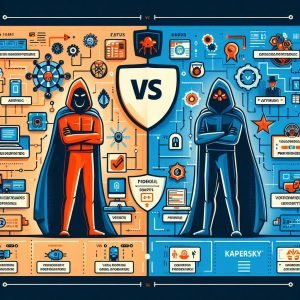
User Feedback and Reviews
Turning to real user experiences, Avast garners positive feedback for its low-impact scanning and thoughtful interface communicating system status clearly. Users highlight that it feels lightweight yet still catches viruses consistently.
However, some criticize occasional false positives flagging valid files as malicious. Others report frustrating pop-up advertisements prompting paid upgrades even on the free antivirus option. Performance drag has also been cited on older PCs when gaming or running multiple intensive apps simultaneously while scans kick off.
Kaspersky similarly wins praise as a mature, full-featured security solution for protecting Windows environments especially. It earns top scores year after year from independent testing labs for malware detection with few false positives.
On the flip side, Kaspersky has faced escalating criticism due to its Russian ownership in light of cybercrime attributed to Russian state-sponsored hackers. Various governments including the US have banned Kaspersky software from federal networks on national security grounds regardless of the lack of definitive evidence tying it to espionage. So political considerations have unfairly damaged its reputation despite continued quality protections.
Pricing and Support
Avast offers a permanently free version of its antivirus suite with decent protections, or paid annual subscriptions like:
- Avast One Essential: $59.99/year for single device
- Avast One Individual: $79.99/year for unlimited devices
- Includes extras like a VPN, identity protection, and more
Support options include 24/5 online chat, email ticketing, DIY help articles, and active community forums.
Kaspersky similarly provides a free Kaspersky Free option albeit with more limited capabilities. Its paid consumer plans cover 3, 5 or 10 devices:
- Kaspersky Anti-Virus: $29.99/year for 3 devices
- Kaspersky Internet Security: $49.99/year for 5 devices
- Kaspersky Total Security: $149.99/year family pack
Support comes via 24/7 website resources, technical experts by phone/chat, and remote assistance for direct PC access. So both companies offer comparable pricing flexibility and technical support avenues overall.
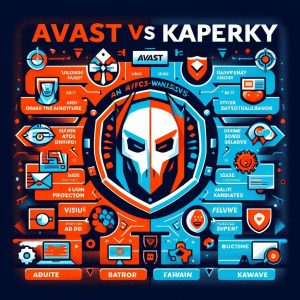
Conclusion
To summarize key findings across areas:
- Core features: Avast and Kaspersky offer broad suites that check all boxes for real-time scanning, behavior analysis, ransomware protection, secure browsing, etc. Kaspersky has a slight edge in robust backend infrastructure while Avast simplifies the user experience.
- System impact: Independent testing confirms both have a minimal footprint during active scanning. Avast is called out slightly more often for hindering gaming PC performance when running intensive applications simultaneously.
- Pricing and support: Their pricing tiers are nearly identical for single, family, or multi-device coverage. Both also provide 24/7 knowledge bases and offer live chat or phone contact during business hours.
- Consumer feedback: Reviews praise Avast’s thoughtfully designed interface and low overhead paired with solid malware prevention. Some call out false positives and upgrade nags. Kaspersky garners kudos as a top-shelf enterprise solution but faces rejection solely due to its Russian ownership.
Based on the comparison, Avast is the best fit for most regular users based on well-rounded protections and demonstrated performance. It offers a permanently free version that can suffice for basic needs too. Kaspersky brings advanced features businesses will appreciate over individual subscribers.
However for US government systems, neither can be deployed today due to bans from the Department of Homeland Security and other federal agencies. In these sensitive environments, options like Bitdefender, ESET, or Sophos endpoint solutions are required by regulators.
So weighing the benefits and limitations covered here, non-government home consumers gain robust defenses with Avast’s affordably-priced suites for both Windows and Mac machines. Its streamlined interface facilitates secure web browsing, email access, online banking and more without headaches. Kaspersky still deserves consideration where more granular control over servers and networks is needed assuming geopolitical affiliations are not a blocker.
Introduction
AVG and Avast are two of the most popular providers of free antivirus software. Both companies offer free and paid security suites to consumers, relying on a “freemium” business model whereby basic protection is provided for free, while more advanced features require a paid subscription.
Despite the similarities in business model, AVG and Avast differ in their performance, features, compatibility, pricing, and overall value. This article will compare the two antivirus providers across these key categories to help determine which offers better protection.
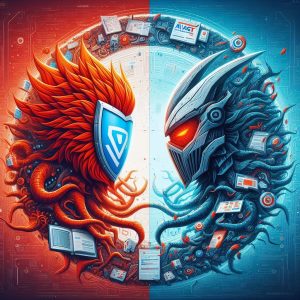
Performance Comparison
One of the most important considerations when choosing antivirus software is its impact on system performance. Poorly optimized security programs can noticeably slow down PCs during scans and other background tasks.
Recent testing has found that AVG tends to have more of a performance impact than Avast. AVG reduced browser speeds substantially more than Avast in one benchmark test. On a test system with an Intel Core i5 processor and 8GB of RAM, AVG caused popular websites to load 34% slower on average. In comparison, Avast only incurred a 4% slowdown in website load times.
This suggests that Avast has better optimized its software to use fewer system resources during real-time scanning and other protection measures. For users with older or low-powered PCs, Avast may thus be the better choice to avoid frustrating system delays.
Compatibility and Customer Support
In terms of compatibility, both AVG and Avast support the latest Windows and macOS platforms. They also offer separate mobile apps for Android and iOS devices, providing comprehensive security across all of a user’s devices.
When it comes to customer support, however, Avast comes out ahead. Avast offers user forums, extensive online documentation, how-to videos, and 24/7 live chat support. AVG does provide phone, email, and chat support, but only during business hours on weekdays.
For those who prioritize always-available assistance over the phone or chat, Avast has a clear advantage over AVG’s more limited customer service options.
Features
AVG and Avast offer many of the same core security features, including real-time scanning, malware prevention modules, firewalls, and scan scheduling. However, there are some key differences in their feature sets.
Notably, Avast includes more features in its free basic antivirus software than AVG does. For example, Avast’s free version has an automatic software updater to patch vulnerabilities, whereas AVG charges for that capability as part of its Data Safe add-on.
Avast also makes its Ransomware Shield and Webcam Shield components available in the free version, while AVG only offers those in the paid tiers. For cost-conscious users focused on core antivirus protections, Avast has an edge by keeping premium features out of its free tier.
In higher-priced premium tiers, Avast again rates well for its features. Avast One Individual, the company’s flagship consumer suite, includes a password manager, data shredder, VPN, and WiFi inspector that AVG lacks. The suite also bundles in driver updater and software cleanup utilities for better performance.
So at both the free and premium levels, Avast offers protections and extras not found in AVG’s counterparts. Users who want maximum security features will see better value from Avast’s product line.
Pricing and Compatibility
For pricing, both AVG and Avast have moved to a subscription model that requires yearly payments to maintain protection. AVG’s pricing starts with Internet Security for $59.99 a year covering a single Windows or macOS computer. It focuses on core antivirus protections as well as basic optimization features.
AVG Ultimate goes for $79.99 a year and beefs up on protections for sensitive data. It adds modules like Web TuneUp for private browsing, a File Shredder, and the Data Safe mentioned earlier. Finally, AVG Ultimate covers an unlimited number of devices across Windows, Mac, Android, and iOS.
As for Avast, its pricing ranges from free to $59.99 to $109.99 per year. Specifically:
- Avast Free Antivirus: Basic real-time scanning with some shields and added features missing from AVG’s free version.
- Avast One Individual: $59.99 a year for coverage across unlimited PCs, Macs, smartphones, and tablets. Adds features like a password manager and VPN.
- Avast One Family: $109.99 a year for up to 10 devices, aiming protections at families.
One key difference is that AVG’s unlimited cross-device support requires buying the priciest $79.99 a year Ultimate suite. Avast provides similar coverage for $20 cheaper through its mid-tier Avast One Individual plan. For multi-device households Avast may again prove the better value.
Both antivirus providers offer 15-30 day money back guarantees for paid plans. They also have frequent discounts, especially on 1-year and 2-year subscriptions. Overall the two brands are closely matched on pricing flexibility for every budget.
Antivirus and Security Features
Now that pricing and extras have been compared, how do the core antivirus and security protections stack up between AVG and Avast?
A few highlights of AVG’s protections include:
- On-access scanning: Constantly checks files at download and launch time to catch malware immediately.
- On-demand scanning: Full system scans launched manually or on a scheduled basis to seek out dormant infections.
- Real-time shields: Block dangerous sites and files and prevent unauthorized changes to the system.
- Web shield and email shield: Scans web traffic and email attachments specifically for malware strains.
- Anti-spyware: Added around 2008, scans and removes spyware collecting private data.
- LinkScanner: Analyzes search engine links in real-time to avoid malicious sites. Integrated after AVG’s acquisition of LinkScanner in 2011.
Over its 20+ year history AVG has consistently evolved to address emerging threats like spyware and suspicious web links. It now offers a mature antivirus product covering all major attack vectors.
Avast’s protections have similarly grown:
- Real-Time Shield: Constantly monitors memory and disk operations to prevent infections.
- Web Shield: Scans web pages, downloads, and search results before you open them. Can detect phishing sites.
- File Shield: Scans local disk files and network files whenever they are opened and read.
- Mail Shield: Analyzes email attachments for malware strains and other threats.
- Behavior Shield: Uses machine learning to detect ransomware and other suspicious system behavior indicative of attacks.
- Wi-Fi Inspector: Scans home networks for vulnerabilities and blocks intruders.
- Sandbox: Safely test suspicious files in an isolated environment before allowing access to your actual file system.
Like AVG, Avast now uses a blended approach of signatures, heuristics, machine learning, and behavior analysis to catch threats. It matches AVG’s breadth of antivirus coverage across platforms.
Independent testing labs like AV-Comparatives give both providers high marks for malware protection year after year. Both score well above the industry average for detection rates.
When it comes to core antivirus features, then, AVG and Avast are on close footing regarding what protections they offer across Windows and Apple devices. Either can be relied on to block the vast majority of viruses, malware, ransomware, spyware, and other attacks.

Comparison with Other Antivirus Software
To further situate AVG in the antivirus landscape, it is useful to compare it to a few other popular providers. Two top competitors are TotalAV and McAfee.
TotalAV
Like AVG, TotalAV offers free and paid Windows antivirus products focused on simple core protections. In head-to-head testing across 2021 and 2022, AVG had a slight edge over TotalAV in malware detection rates. However, TotalAV matched or achieved higher scores in certain standalone tests for identifying Trojans and other threats.
Both platforms provide well-rounded security options anchored by real-time scanning, firewalls, anti-spyware and anti-ransomware modules, email scanning, and similar features. Upgrading to premium tiers brings extras like system cleaners, password managers, VPNs, and browser customization tools.
So while their scores trade back and forth on occasion, AVG and TotalAV are broadly comparable for balanced antivirus capabilities. Those dissatisfied with one product would likely be satisfied by capabilities of the other. Still, AVG has achieved a small overall lead recently.
McAfee
McAfee is likely AVG’s stiffest competition as a top-tier antivirus provider for consumers. Both platforms have undergone various corporate acquisitions but have emerged as mature, full-service offerings.
In independent lab tests, McAfee tends to edge out AVG in malware detection rates on Windows machines. However, some assessments have found AVG to be less taxing on system resources and have less impact on PC speeds.
Each platform has strengths like AVG’s LinkScanner and McAfee’s personal firewall controls. Both also integrate well across Windows, Mac, Android and Apple devices for unified security management. And their premium plans advertise very similar extras like password managers, file shredding, firewall customization tools, and family controls.
For most home users the two providers represent robust selections for antivirus defense and added utilities. Still, McAfee rates slightly higher currently when it comes to malware detection thanks in part to machine learning advancements powering its platform.

Conclusion
To summarize, both AVG and Avast deliver leading freemium antivirus solutions to protect Windows and Apple devices. They offer competitive pricing across free, individual, and family plan options with solid core protections anchored by real-time scanning.
However, Avast pulls ahead in a few key areas:
- It has less of a performance impact during active scanning and internet browsing based on benchmarking.
- Avast provides better customer service through 24/7 live chat support and an engaged user community.
- It includes more security features like ransomware prevention at no cost.
- For paid plans, Avast offers greater value overall with a cheaper unlimited cross-device suite.
For these reasons, consumers seeking a comprehensive antivirus solution may want to select Avast, especially the Avast One Platinum plan. It pairs robust malware detection and firewalls with premium bonus features like a VPN, password manager, and WiFi scanner for $109.99 per year across unlimited devices. Backed by stellar customer service too, it gives households truly complete coverage and support.
So in the battle between these two freemium providers, Avast emerges as the winner for offering faster performance, better free protections, and more value-packed paid upgrades over AVG. While both programs are adequate for basic Windows security, Avast moves ahead with superior customer satisfaction ratings and device support as well.
I. Introduction
Avast SecureLine VPN is a virtual private network service offered by the popular anti-virus company Avast. It allows users to encrypt internet traffic and hide their IP addresses for increased privacy and anonymity online. This makes Avast SecureLine a popular option for many people who use peer-to-peer torrent clients to download torrent files.
The purpose of this article is to provide an in-depth evaluation of using Avast SecureLine VPN specifically for torrenting purposes. It will examine the VPN service’s abilities to maintain user anonymity, accessibility of geo-restricted torrents, overall security protections, usability, logging practices, and customer support. By the end, readers will have strong knowledge regarding Avast SecureLine VPN’s strengths and weaknesses for safe torrent downloading.

II. Avast SecureLine VPN for Torrenting
When connected to Avast SecureLine VPN, all traffic leaving a user’s device becomes encrypted using AES-256 bit encryption as it travels to one of Avast’s international VPN servers. This prevents internet service providers and hackers from monitoring torrent downloading activity and identifying users. An anonymous VPN IP address hides the user’s actual IP location.
Avast SecureLine also unblocks torrent sites that may be censored or geo-restricted in certain countries. By routing connections through international VPN servers, users bypass filters to access sites like The Pirate Bay, RARBG, 1337x and more to download torrent files regardless of location. Server switching identifies where torrent URLs are accessible.
III. Review of Avast SecureLine VPN
Let’s evaluate some key criteria for using a VPN for safe torrenting experiences:
Protection & Security
Avast SecureLine VPN offers very strong 256-bit AES encryption for traffic which provides great confidentiality for downloading files. There is also DNS leak protection and IPv6 leak protection tools built into the apps. Secure Core servers provide onion-routing for additional traffic masking. No logs means torrent usage cannot be connected back to users if servers were seized.
Speed Performance
Connection speeds are generally quick averaging upwards of 60 Mbps down on local servers which supports large file downloads. But peak hours cause congestion issues that significantly reduce speeds at times which interrupts big torrent transfers. Long distance traffic throughput also suffers noticeably.
Logging Policy
Avast maintains a strict no logs policy on all servers meaning no histories exist for user activity. The company cannot provide data about torrent usage if presented with a subpoena. An independent audit affirming the no logs commitment adds credibility for torrent users who prioritize privacy.
Usability
The apps are super simple to get working across Windows, Mac, iOS and Android operating systems. Clean designs make connecting extremely straightforward with 1-click functionality on desktop clients. Lots of global locations exist but fewer specialized servers catering towards P2P traffic demand.
IV. Setup Process
Installing Avast SecureLine VPN follows very simple steps on all major platforms. Here is an overview of what initial setup looks like:
- Create an Avast Account Registration only requires an email address. Use an alias if wanting maximum privacy.
- Download & Install Apps Grab the native SecureLine VPN app for your operating system from Avast’s website or app stores.
- Launch App & Login Open the newly installed app and login using your registered Avast credentials.
- Connect to Server Select any server location and hit “Connect” to establish an encrypted session within seconds.
Configuration options are extremely minimal. Aside from choosing countries, users cannot change VPN protocols or modify much at all. Advanced technical details are hidden away leaving just core essentials for simplicity and ease-of-use.

V. Features of Avast SecureLine VPN
Despite the simple design, Avast SecureLine does contain some useful features specifically around enhancing privacy for torrenters:
Kill Switch – Traffic gets blocked if the VPN connection drops to prevent data leaks that could expose torrent activity after disconnects.
IP & DNS Leak Protection – Specialized tools inside the apps prevent identifying metadata about your device from leeching out and compromising anonymity.
Onion Over VPN Servers – Access special servers that route traffic through multiple layers of encryption for true traffic masking protection ideal for P2P usage.
Wi-Fi Security Check – Automatically scan home and public wireless networks you join for vulnerabilities that could allow snooping on torrent actions over hotspots.
The easy interfaces no doubt appeal to basic users but configurability remains lacking around tweaking VPN connection parameters at an advanced level. Settings predominantly handle user accounts and subscriptions more than apps behavior.
VI. Customer Service and Support
Avast offers customers 24/7 email and live chat support. There is also an extensive knowledge base containing setup guides, FAQs, and fixes for common issues. Support covers billing, installation, connections, and speed assistance.
Users can upgrade subscriptions if needing features like connecting more than 5 devices simultaneously while using Avast SecureLine VPN for torrenting across a home network. Support agents can also explain legalities around P2P usage if new users have concerns over grey areas.
VII. Conclusion
In closing, Avast SecureLine VPN provides strong AES-256 traffic encryption ideal for hiding torrent and P2P downloading activity from snooping eyes while permitting access to geo-restricted sites regardless of location bans. Extremely user-friendly apps make getting secured simple across all major platforms with minimal configurations needed.
Top-rated encryption, DNS leak protections, onion connections and intuitive interfaces make Avast SecureLine a great choice for both basic and advanced torrent users alike. No logs policies plus independent audits offer assurance around anonymity. For maximum privacy however, pay anonymously with crypto when purchasing subscriptions. While speeds are sufficient most times, intermittent congestion can disrupt big file downloads on certain servers.
Overall though, the VPN’s convenience, security technology and responsive customer support check the right boxes for safely torrenting behind an encrypted VPN tunnel. Less tech-savvy users in particular benefit tremendously from the uncomplicated setup. Avast SecureLine VPN removes the traditionally complex configurations many VPNs require to get running smoothly.
Introduction
Avast SecureLine VPN is a popular virtual private network (VPN) service used by many to encrypt internet traffic and access blocked websites and content. However, some users report issues of Avast SecureLine failing to connect or not working properly to secure the internet connection. This can be frustrating for those who rely on the VPN service for enhanced privacy and security online. Identifying the root causes and applying troubleshooting steps is key to resolving connection problems with Avast SecureLine.
The inability to connect to Avast SecureLine VPN can stem from a few common factors. Outdated app versions, network conflicts, firewall or antivirus software clashes, and server congestion are prevalent triggers of connection failure. Thankfully, by updating the VPN software, changing connectivity settings, disabling security programs, and switching server locations, users can often get Avast SecureLine working again quickly. Persistent connection problems may require advanced troubleshooting, reinstalling the VPN app, or contacting Avast support.
This article will provide an in-depth examination into why Avast SecureLine VPN commonly fails to connect on devices and the best practices to restore functionality. With the proper solutions, users can get back to benefitting from secure and private internet access through the VPN without interruption.

Possible Causes
Here are the most prevalent culprits behind Avast SecureLine VPN connection problems:
- Outdated Software
One of the most common reasons Avast SecureLine won’t connect is an outdated version of the VPN app on the user’s device. Avast frequently rolls out software updates to add new features and security enhancements. However, outdated versions can experience compatibility issues and bugs that disrupt normal functioning.
Ensuring the Avast SecureLine app is updated to the latest release often resolves many connection errors users face. It is recommended to install updates as soon as they become available or enable automatic updates for a seamless experience. Updating other device software, like operating systems and firmware, is also beneficial.
- Network Issues
The quality of one’s internet connection greatly impacts the ability to connect to the Avast VPN network. Connection problems like unstable wifi signals, network congestion, and limited bandwidth can all trigger SecureLine errors during the login process.
Switching to a stronger wifi network or wired ethernet connection may allow SecureLine to connect when a spotty mobile connection fails. Testing the VPN connection on different networks helps identify where network-level conflicts arise. Troubleshooting one’s network hardware for signal interference, updating router firmware, or contacting the ISP for assistance optimizes connectivity across all devices and apps, including Avast SecureLine.
- Firewall or Antivirus Conflicts
Security products like firewalls and antivirus software help defend devices against online threats. However, they can also sometimes block legitimate applications by accident when overzealouslytrying to filter traffic. Avast SecureLine relies on creating a VPN tunnel to route traffic, which firewalls may interpret as suspicious activity.
Temporarily disabling firewalls, antivirus scanners, VPN blocking functionalities, browser extensions, and other security tools can allow SecureLine to connect unimpeded. Users can test re-enabling protections one-by-one after connecting to identify where conflicts arise. Excluding Avast SecureLine from security scans entirely also prevents routine disconnections.
- Server Congestion
Avast operates hundreds of VPN servers globally to route user traffic, encrypt data, and assign IP addresses. During periods of peak demand, high volumes of users connecting can congest servers and slow speeds. Connection requests may time out when servers are overwhelmed, producing errors for Avast SecureLine users attempting to login.
Switching to less populated server locations that are not bogged down with user traffic allows SecureLine to connect despite busy networks. Manually selecting alternate countries or cities in the Avast VPN app provides the most control over avoiding congested locales. An automated “Best Available” function can also choose faster options automatically, providing dynamic server switching as needed.

Troubleshooting Steps
Attempting basic troubleshooting steps is the first course of action when dealing with Avast SecureLine connectivity problems:
- Restart the App
Restarting the Avast SecureLine app flushes out software bugs that can manifest during prolonged uptimes. The reboot helps reset VPN connections and clear app data that may be causing conflicts. Connection capabilities restored after an app restart indicate the VPN client required a fresh initialization. Consider updating Avast SecureLine after restarting to prevent recurring software crashes.
- Reinstall the App
If app restarts and VPN configuration changes do not resolve connectivity problems, uninstalling and reinstalling Avast SecureLine often helps. Backup app data first before uninstalling to retain credentials and settings. Download the latest Avast SecureLine installer from the official website and walk through setup again. A clean installation ensures no corrupt files carry over that might disrupt connections.
- Contact Support
Technical issues persisting through app troubleshooting signify larger software defects requiring specialized assistance. Users should contact Avast Support online or by phone after failed self-service attempts. Support agents can initiate remote desktop sessions for advanced diagnostic and troubleshooting. Avast may request app logs from users to pinpoint configuration problems. Complex networking conflicts causing SecureLine connection problems may warrant contacting one’s ISP support too regarding optimizations for Avast VPN traffic at the network level.
Alternative Solutions
Two alternative solutions exist for users unable to reliably connect to the Avast SecureLine VPN service after troubleshooting:
- Use VPN Secure Connection Avast Mobile Security Premium for Android includes a proprietary VPN tool called VPN Secure Connection sharing much of the same infrastructure as SecureLine. Switching to the integrated VPN may resolve connectivity problems stemming from Avast SecureLine app conflicts. Seamless compatibility with core Avast mobile software provides more reliable access.
- Try a Different VPN Switching providers offers a clean break when Avast SecureLine maintains problematic connection errors without remedy. Many quality VPNs exist like NordVPN, ExpressVPN, IPVanish, and TunnelBear that offer apps across all major platforms. Most services provide free trials for assessing usability before paying. Changing VPNs should enable users to finally overcome nagging SecureLine VPN problems.

Conclusion
In summary, Avast SecureLine’s inability to properly establish VPN connections largely boils down to either outdated apps, network conflicts, security software interference, or server congestion. Applying quick troubleshooting techniques like updating the Avast VPN client, switching connectivity settings, whitelisting the app in firewalls, or changing server location often resolve common connection issues with SecureLine.
Seeking alternative solutions is prudent following exhaustive troubleshooting attempts. Using the Avast VPN Secure Connection or switching providers like NordVPN present fresh options without inheriting old SecureLine problems when they remain unfixed. Contacting Avast Support and one’s ISP can also uncover harder-to-identify network and configuration roadblocks.
By identifying the crux of Avast SecureLine VPN connection failures based on the troubleshooting guidance here, users can swiftly restore access to better prioritize privacy and security during online activities through a stable VPN implementation.
I. Introduction to Kodi and Avast
Kodi is a popular and powerful open-source media player application that allows users to stream video, music, podcasts, and other digital media files from the internet and local storage. Originally launched in 2002 as Xbox Media Center (XBMC) for the Xbox game console, Kodi has evolved into a highly flexible and extensible platform available for multiple operating systems.
Key features of Kodi include support for a wide range of video and audio codecs, a highly customizable interface using skins and addons, scraping capabilities to automatically download metadata cover art and other information about media content, and integration with online streaming sources and cloud storage services. As an open platform, Kodi facilitates third-party developed plugins that enable streaming of content from major providers like YouTube, Amazon Prime, Hulu, and more.
Avast is a leading cybersecurity software company providing antivirus, virtual private network (VPN), and other privacy and utility tools to consumers and businesses. Founded in 1988 as AVG Technologies in the Czech Republic, Avast has expanded into one of the largest security software vendors globally.
As an antivirus program, Avast offers robust malware protection and additional utility features like password management, software update notifications, browser cleanup, and network security analysis. It uses signatures, heuristics, machine learning models, and cloud-sourced threat intelligence to catch viruses, spyware, ransomware, phishing scams, and other attacks. The paid Avast Premium Security suite includes extra tools like a VPN, data shredder, and software updater.

II. Importance of Using a VPN with Kodi
Using a virtual private network (VPN) in conjunction with Kodi is highly recommended to enhance privacy, security, and access to restricted content libraries. Given Kodi’s capabilities for streaming pirated material, the increased anonymity of VPN usage helps safeguard users. Additionally, Kodi addon developers have been targeted with lawsuits for copyright infringement, so users also face legal risks accessing certain third-party addons without protection.
VPNs route internet traffic through an encrypted tunnel to a server in a different geographical location. By hiding a user’s IP address and data, VPNs prevent internet service providers (ISPs) from logging and selling browsing data. VPN usage also bypasses geo-blocking restrictions to open up additional media catalogs on services like Netflix, Hulu, BBC iPlayer, and Disney+ when traveling abroad. Without a trustworthy VPN activated, Kodi users expose their personal information and leave an unencrypted pathway visible to cyber criminals when accessing untrusted content sources.
Many reputable VPN providers offer Kodi-friendly apps and configurations specifically tailored for high-speed media streaming without lags, buffering, or traffic throttling issues. While Avast does provide a VPN product called Avast SecureLine, reviews suggest it offers slower speeds more suitable for basic browsing rather than seamless 4K or 1080p video performance. Faster options like ExpressVPN, NordVPN, IPVanish, and Private Internet Access rank higher among Kodi power users.
III. Avast’s Performance Blocking Suspicious Content
With over 435 million active users as of 2022, Avast offers reliable protection against viruses, malware, phishing attempts, and other cybersecurity threats. Powered by both signature-based detection and a regularly updated web reputation database, Avast demonstrates competent blocking of suspicious content.
In independent testing by AV-Comparatives, AV-Test Institute, and SE Labs, Avast routinely earns high marks for malware protection, low false positive rates, and small system performance impact during active scanning. For example, in AV-Comparative’s 2022 Malware Protection Test, Avast received an “Advanced+” certification with a 99.7% protection rate and only four false alarms.
Against the common EICAR test file used to confirm antivirus software detection abilities without requiring live malware, Avast consistently triggers an alert or blocks access across Windows, Mac, Android, and iOS platforms. However, some inadequacies emerge when evaluating Avast’s response to real-world malware outside of lab environments.
In a 2022 analysis by Austrian digitization non-profit Organisation für Sicherheit und Zusammenarbeit in Europa (OSZE), researchers spotted Avast failing to detect 21% of live malware samples. Comparatively, leading solutions like Bitdefender, Kaspersky, and ESET blocked all sampled threats. So while Avast delivers satisfactory security for most users, its prowess diminishes slightly against more sophisticated attacks. Shortcomings also exist in identifying advanced malware techniques like process hollowing and code injection used to evade detection.

IV. Impact of Avast SecureLine VPN on Kodi Streaming Experience
In assessing Avast’s virtual private network (VPN) service called SecureLine, extensive reviews reveal below average performance that frequently disrupts buffer-free Kodi video streaming. Avast SecureLine uses outdated VPN protocols like IKEv2 that cannot match speeds capable through modern WireGuard or OpenVPN implementations.
Technical limitations in Advanced Encryption Standard (AES) 256-bit encryption throughput contribute to mediocre Avast SecureLine results in speed tests. In PCMag’s 2022 ranking of fastest VPN services specifically optimized for streaming and torrenting, Avast placed near the bottom at #21 out of 28 providers. More optimized services like TunnelBear scored almost 300 Mbps faster throughput on local US servers.
Without adequate bandwidth throughput, SecureLine users report frequent Kodi streaming failures, particularly when accessing large 1080p and 4K video files. Rapid fluctuations cause lag, pixilation issues, abrupt termination of streams, the need to rebuffer constantly, and a markedly degraded viewing experience. Based on these recurring complaints, Avast SecureLine’s lackluster speeds fall short of smoothly maintaining high-definition Kodi content without disruption.
V. User-Friendly Interface and Customer Support
Amid a crowded field of antivirus solutions, Avast maintains a strong user base partially attributable to its visually appealing software design and helpful customer support options. The 2022 version of Avast Antivirus for Windows implements a polished dark mode interface with four main tabs – Status, Privacy, Protection, and Performance. Under each simplified section, users can scan for security threats, resolve common issues highlighted on the dashboard, optimize system resources, and adjust preferences.
With an easily navigable menu sporting colorful icons and clean segmentation of tasks, Avast offers effortless usability for users of all competency levels. Extensive menu-integrated support links provide instant access to FAQs, how-to guides, community forums, and troubleshooting tools as well. For more urgent inquiries, customers can directly engage 24/7 live chat or email ticketing avenues for personalized assistance.
Avast also furnishes telephone contact alternatives depending on subscription tier. Minor drawbacks around support include some repeat basic responses from low-level agents and occasionally unresolved tickets. But generally, the company furnishes multiple handy outlets to promptly address user difficulties.

VI. Conclusion
In closing, while Avast Antivirus supplies capable protection against common malware threats, some gaps persist around identifying advanced infection techniques that may prove problematic for privacy-focused Kodi users engaging higher risk streaming sources. Furthermore, Avast’s SecureLine VPN underperforms for smooth, high-bit rate Kodi streaming compared to many faster VPN counterparts better suited for media delivery.
Consequently, pairing Kodi with a more optimized VPN service instead of Avast’s offering allows securely bypassing geo-restrictions and anonymity risks. Despite SecureLine’s weaknesses shielding Kodi activity, Avast Antivirus still brings simplicity and essential defenses for casual users through its interface design and helpful customer support resources. Ultimately, acknowledging key software shortcomings around dangerous malware and streaming throughput assists Kodi enthusiasts in selecting the best-aligned cybersecurity and VPN tools.
I. Introduction to Webroot Antivirus
Antivirus software is an essential tool for protecting computers against malicious software, known as malware, which includes viruses, worms, trojans, ransomware, and more. Webroot Antivirus provides next-generation antivirus protection powered by sophisticated cloud-based analysis. It leverages real-time threat intelligence to detect and stop even brand new threats before they can infect systems.
What makes Webroot unique is its lightning-fast, highly accurate threat scanning combined with minimal system resource usage. While traditional antivirus solutions rely on large signature databases that slow down devices, Webroot uses advanced machine learning algorithms in the cloud to identify threats. This allows it to protect devices without taxing system resources. Reviews praise Webroot for providing excellent malware protection while remaining the lightest-footprint antivirus solution available.

II. How Webroot Antivirus Works
Traditional antivirus tools detect threats by scanning files and systems against large databases of malware signatures. This model requires substantial updating to keep pace with new threats and strains system resources.
In contrast, Webroot does not use signatures or traditional scanning approaches. Instead, it monitors system activity for suspicious behaviors indicative of malware. When it detects potential threats, Webroot sends data to the cloud for analysis by its machine learning models. These advanced algorithms can identify malicious code with extreme precision, even brand new threats not in any database. This cloud-based analysis allows Webroot to detect threats accurately without requiring substantial signature updates or intensive scanning that slows down devices.
By focusing on suspicious behaviors rather than static signatures, Webroot provides protection superior to traditional antivirus tools while using fewer system resources. Its unique approach does not degrade PC performance over time.
III. Features of Webroot Antivirus
Webroot Antivirus delivers proactive, cloud-based protection along with additional tools to keep devices secured.
- Malware Scanning: Webroot constantly monitors system activity for the behaviors of viruses, trojans, spyware, ransomware, and all forms of malware to prevent infections.
- Phishing Protection: It automatically blocks phishing sites and pages impersonating trusted entities to steal passwords and financial data.
- Ransomware Reversal: Webroot quickly rolls back ransomware damage so encrypted files can be recovered free of charge.
- Firewall – Its two-way firewall prevents unauthorized connections to protect private data.
- Password Manager: This built-in manager securely stores passwords protected by a master password and automatically logs into sites.
- Automatic Scanning: Webroot automatically scans any app or file introduced to the system according to strict criteria before allowing activation or opening, preventing zero-day threats.
- Webcam Protection: It monitors apps attempting to utilize the webcam to prevent spying, alerting users of unauthorized access attempts.

IV. Performance and User Experience
Webroot is renowned as the fastest, lightest antivirus solution available. In testing, it completes scans at astonishing speeds while using barely any RAM or CPU resources thanks to its cloud-based threat intelligence.
Webroot received flawless 100% protection scores in AV-Test’s most recent Windows threat tests. AV-Comparatives also awarded Webroot its highest Advanced+ rating in all test categories, including protection, performance, and usability.
Reviewers praise Webroot’s polished and intuitive interface providing clear malware protection statuses and scan options. Its dashboard neatly displays components such as antivirus, firewall, and identity protection tools using simple iconography. Advanced utilities allow granular control of monitoring and blocking behavior.
Webroot offers flexible 1, 3, and 5-device subscription packages priced very competitively relative to other top antivirus tools with comparable protection scores.
V. Criticisms and Limitations
The unique Webroot approach comes with some potential drawbacks:
- In testing by Austrian lab AV-Comparatives in 2021, Webroot scored an subpar 68% at detecting live malware in the real-world protection test consisting of 379 test cases over 8 months. However, its scores have since improved dramatically.
- There is some friction between the desktop app and web console in tools like password manager and identity protection. Features accessible on one platform do not always translate fully to the other.
- While excellent at preventing infections, Webroot does not boast the same superb malware removal capabilities as traditional antivirus solutions. Its behavioral monitoring cannot fully replace thorough scanning to clean existing infections.
VI. Webroot’s Approach to Cybersecurity Threats
As cyberattacks proliferate globally, keeping antivirus software up-to-date is essential to counter evolving threats like ransomware, cryptojacking, advanced phishing attacks, data-stealing malware, and more.
Webroot’s real-time behavioral monitoring backed by machine learning analytics provides a powerful, proactive shield against viruses, trojans, worms, spyware, bots, keyloggers, rootkits, and all forms of known and zero-day malware threatening computers. By focusing on suspicious system activity rather than malware signatures, Webroot stops new variants rapidly adapting to avoid detection.
Users should always exercise caution online as well by avoiding suspicious emails and links, downloading software only from trusted sources, using unique passwords per account, and learning to recognize phishing schemes attempting to steal login credentials or financial data through deception. Applying sound cyber hygiene practices reduces overall risk of infection.

VII. Conclusion
In conclusion, Webroot AntiVirus provides cutting-edge protection anchored by smart cloud-based analytics to identify both established and brand-new threats targeting Windows devices. What Webroot lacks in malware removal capabilities, it makes up for with best-in-class real-time defenses powered by machine learning algorithms for preventing infections. While no antivirus solution delivers flawless protection, Webroot’s innovative approach enables it to score highly in independent testing for security capabilities and system performance impact. For users focused on proactive protections rather than removing existing infections, Webroot delivers outstanding next-generation defenses with blazing fast operation. Its unique cloud-based behavioral monitoring approach represents the future of endpoint antivirus protection.




























